Citation guides
All you need to know about citations

How to cite a dissertation in APA
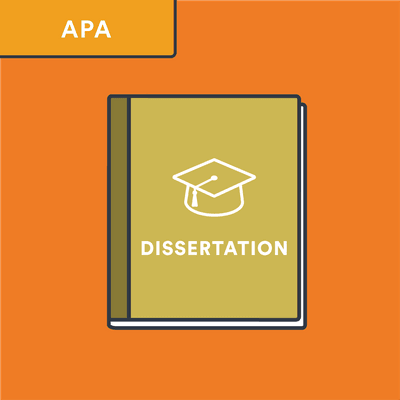
- Google Docs
To cite a dissertation in a reference entry in APA style 6th edition include the following elements:
- Author(s) of the dissertation: Give the last name and initials (e. g. Watson, J. D.) of up to seven authors with the last name preceded by an ampersand (&). For eight or more authors include the first six names followed by an ellipsis (…) and add the last author's name.
- Year of publication: Give the year in brackets followed by a full stop.
- Title of the dissertation: Only the first letter of the first word and proper nouns are capitalized.
- URL: Give the full URL where the document can be retrieved from.
Here is the basic format for a reference list entry of a dissertation in APA style 6th edition:
Author(s) of the dissertation . ( Year of publication ). Title of the dissertation (Doctoral dissertation). Retrieved from URL
If the dissertation is available from a database, archive or any online platform use the following template:
- Author(s) of the dissertation: Give the last name and initials (e. g. Watson, J. D.) of up to 20 authors with the last name preceded by an ampersand (&). For 21 or more authors include the first 19 names followed by an ellipsis (…) and add the last author's name.
- Publication number: Give the identification number of the dissertation, if available.
- Name of the degree awarding institution: Give the name of the institution.
- Name of platform: Give the name of the database, archive or any platform that holds the dissertation.
- URL: If the dissertation was found on a database, omit this element.
Here is the basic format for a reference list entry of a dissertation in APA style 7th edition:
Author(s) of the dissertation . ( Year of publication ). Title of the dissertation ( Publication number ) [Doctoral dissertation, Name of the degree awarding institution ]. Name of platform . URL
If the dissertation has not been published or is available from a database use the following template:
- Location: Give the location of the institution. If outside the United States also include the country name.
Author(s) of the dissertation . ( Year of publication ). Title of the dissertation (Unpublished doctoral dissertation). Name of the degree awarding institution , Location .
If the dissertation is not published, use the following template:
Author(s) of the dissertation . ( Year of publication ). Title of the dissertation [Unpublished doctoral dissertation]. Name of the degree awarding institution .
APA reference list examples
Take a look at our reference list examples that demonstrate the APA style guidelines for a dissertation citation in action:
A dissertation found in an online platform
Guo, J . ( 2018 ). Trust-based service management of internet of things systems and its applications ( Doctoral dissertation ). Retrieved from https://vtechworks.lib.vt.edu/handle/10919/82854
Guo, J . ( 2018 ). Trust-based service management of internet of things systems and its applications [ Doctoral dissertation , Virginia Tech ]. ETDs: Virginia Tech Electronic Theses and Dissertations . https://vtechworks.lib.vt.edu/handle/10919/82854
An unpublished doctoral dissertation
Neel, B. L . ( 2017 ). Three flute chamber works by Alberto Ginastera: Intertwining elements of art and folk music ( Unpublished doctoral dissertation ). University of Nebraska-Lincoln , NE .
Neel, B. L . ( 2017 ). Three flute chamber works by Alberto Ginastera: Intertwining elements of art and folk music [ Unpublished doctoral dissertation ]. University of Nebraska-Lincoln .

This citation style guide is based on the official Publication Manual of the American Psychological Association ( 6 th edition).
More useful guides
- APA Referencing: Theses
- Reference List: Other Print Sources
- APA 6th Edition Citation Style
More great BibGuru guides
- Chicago: how to cite a financial report
- AMA: how to cite a database
- Chicago: how to cite a song
Automatic citations in seconds
Citation generators
Alternative to.
- NoodleTools
- Getting started
From our blog
- 📚 How to write a book report
- 📝 APA Running Head
- 📑 How to study for a test

- Collections
- Research Help
- Teaching & Learning
- Library Home
APA 7th Edition Citation Style Guide
- Basics & Help
- Journal Articles
- Web Sources
- Magazine & News Articles
- Audiovisual Media
- Data & Reports
- Legal Documents
From a Database
From the web, unpublished (in print from a university library).
- References Page
- In-text Citations
- Author Variations (more than 1, or group)
- Citing Business Resources
General Rule:
Author, A. A. (year). Title of doctoral dissertation or master’s thesis (Publication No. #) [Doctoral dissertation or master’s thesis, Name of Institution Awarding the Degree]. Name of Database.
Davis, P. M. (2010). Access, readership, citations: A randomized controlled trial of scientific journal publishing . (Publication No. 3429815 ) [Doctoral dissertation, Cornell University]. ProQuest Dissertations and Theses Global.
Author, A. A. (year). Title of doctoral dissertation or master’s thesis [Doctoral dissertation or master’s thesis, Name of Institution]. Name of Website. URL
Buckman, A. (1997). MOOSE Crossing: Construction, community, and learning in a networked virtual world for kids [Doctoral dissertation, Massachusetts Institute of Technology]. DSpace@MIT. https://dspace.mit.edu/handle/1721.1/33821
Author, A. A. (year). Title of doctoral dissertation or master’s thesis [Unpublished doctoral dissertation or master’s thesis]. Name of Institution.
Long, R.P. (1972). A study of instructional objectives and methods for interpersonal communication. [Unpublished master’s thesis]. West Virginia University.
- << Previous: Legal Documents
- Next: References Page >>
- Last Updated: Feb 29, 2024 4:13 PM
- URL: https://libguides.wvu.edu/apa
APA Style 7th Edition: Citing Your Sources
- Basics of APA Formatting
- In Text Quick View
- Block Quotes
- Books & eBooks
- Thesis/Dissertation
Standard Format
Formatting rules, various examples.
- Audiovisual
- Conference Presentations
- Social Media
- Legal References
- Reports and Gray Literature
- Academic Integrity and Plagiarism
- Additional Resources
- Reference Page
Adapted from American Psychological Association. (2020). Publication manual of the American Psychological Association (7th ed). https://doi.org/10.1037/0000165-000
Formatting:
- Italicize the title
- Identify whether source is doctoral dissertation or master’s thesis in parentheses after the title
See Ch. 10 pp. 313-352 of APA Manual for more examples and formatting rules
- << Previous: Articles
- Next: Websites >>
- Last Updated: Apr 22, 2024 9:37 AM
- URL: https://libguides.usc.edu/APA7th

- Otis College of Art and Design
- Otis College LibGuides
- Millard Sheets Library
Citation Guide (MLA 9th Edition) UNDER CONSTRUCTION
- Theses and Dissertations
- Title of source
- Title of container
- Contributor
- Publication date
- Supplemental Elements
- Advertisements
- Books, eBooks & Pamphlets
- Class Notes & Presentations
- Encyclopedias & Dictionaries
- Government Documents
- Images, Charts, Graphs, Maps & Tables
- Interviews and Emails (Personal Communications)
- Journal Articles
- Magazine Articles
- Newspaper Articles
- Religious Texts
- Social Media
Citation Templates
Print versions, electronic versions.
- Videos & DVDs
- When Information Is Missing
- Works Quoted in Another Source
- In-Text Citations
- Sample Works Cited List
- Sample Annotations This link opens in a new window
- Plagiarism This link opens in a new window
Dissertations and theses
Dissertations and theses are written to fulfil an academic degree requirement, usually at the Masters or PhD level. They usually have only 1 author.
For the most part, treat them like books with supplemenal elements.
- Since dissertations and theses are often re-worked into articles and books, it is important to note when your source was written to fulfill an academic degree requirement
- The publisher is the degree-granting instution
- Do not include the program, department, school, division, or similar information
- Usually placed before the container of the online repository which houses the publication
- Automatic citation generators often treat online theses and dissertations as websites or journal articles, so will be missing the key information
Author's Last Name, First Name. Title of Book: Subtitle. Publication Date. University name, Degree conferred .
Author's Last Name, First Name. Title of Book: Subtitle. Publication Date. University name, Degree conferred . Online Repository , URL.
In-Text Citation
(Author's Last Name ##)
Replace ## with page number(s) for quotes or where the idea is discussed.
Smith, Kate Elizabeth. The Influence of Audrey Hepburn and Hubert de Givenchy on American Fashion, 1952-1965 . 2001. Michigan State University, MA Thesis.
Austin, Katherine. Rasquache Baroque in the Chicana/o Borderlands . 2012. McGill U, PhD thesis. eScholarship , https://escholarship.mcgill.ca/concern/theses/8p58ph61j. Accessed 6 Jan. 2023.
- eScholarship is McGill University's online repository of dissertations and theses
- Followed McGill's lead and used "thesis" instead of "dissertation"
Grullon, Jaymi Leah. Campy Musical Black Queer Forms: Finding Utopia in Lil Nas X's World of "Montero ". St. John's University, MA Thesis. St. John's Scholar , https://scholar.stjohns.edu/theses_dissertations/477
- St. John's Scholar is the university's online repository of dissertations and theses
Hutchinson, Jennifer. Emotional Response to Climate Change Learning: An Existential Inquiry . 2021. Antioch University, Antioch University, Doctoral dissertation. EBSCOhost , search.ebscohost.com/login.aspx?direct=true&AuthType=ip,sso&db=ddu&AN=29DBEAFBF585BC45&site=eds-live&scope=site.
- Found record in OwlCat, so used EBSCOhost as the repository
- Could be more specific and replace the EBSCOhost info with: OhioLINK Electronic Theses and Dissertations Center , http://rave.ohiolink.edu/etdc/view?acc_num=antioch1602019356792951.
- << Previous: Social Media
- Next: Videos & DVDs >>
- Last Updated: Feb 23, 2024 4:22 PM
- URL: https://otis.libguides.com/mla_citations
Otis College of Art and Design | 9045 Lincoln Blvd. Los Angeles, CA 90045 | MyOtis
Millard Sheets Library | MyOtis | 310-665-6930 | Ask a Librarian

Art: MFA Thesis: Citing Sources
- Articles & Databases
- Audio / Video
- Copyright & Fair Use
- Thesis & Dissertation Deposit
Citation Management Tools
- Citation and Reference Management Research Guide
iThenticate

- APA Style APA help from the American Psychological Association
- APA Style Blog (Seventh Edition) Great place to search for answers to your APA Style questions
- Excelsior OWL: APA Style A resource from Excelsior College
General Citation Help
Note: The Cite Your Source Automatically citation generator feature on the Purdue OWL website is a commercial product and not recommended.
Use any citation generator app with caution. See Using Citation Generators Responsibly (Purdue OWL).
- Citation Styles Guide (University of Pittsburgh)
- Excelsior Online Writing Lab (OWL)
- Purdue Online Writing Lab (OWL)
- << Previous: Data
- Next: Copyright & Fair Use >>
- Last Updated: Apr 19, 2024 1:09 PM
- URL: https://guides.library.cmu.edu/art_MFA
Home / Guides / Citation Guides / MLA Format / How to Cite a Thesis or Dissertation in MLA
How to Cite a Thesis or Dissertation in MLA
Citing a thesis or dissertation.
Thesis – A document submitted to earn a degree at a university.
Dissertation – A document submitted to earn an advanced degree, such as a doctorate, at a university.
The formatting for thesis and dissertation citations is largely the same. However, you should be sure to include the type of degree after the publication year as supplemental information. For instance, state if the source you are citing is an undergraduate thesis or a PhD dissertation.
MLA Thesis and Dissertation Citation Structure (print)
Last, First M. Title of the Thesis/Dissertation. Year Published. Name of University, type of degree.
MLA Thesis and Dissertation Citation Structure (online)
Last, First M. Title of the Thesis/Dissertation. Year Published. Name of University, type of degree. Website Name , URL.
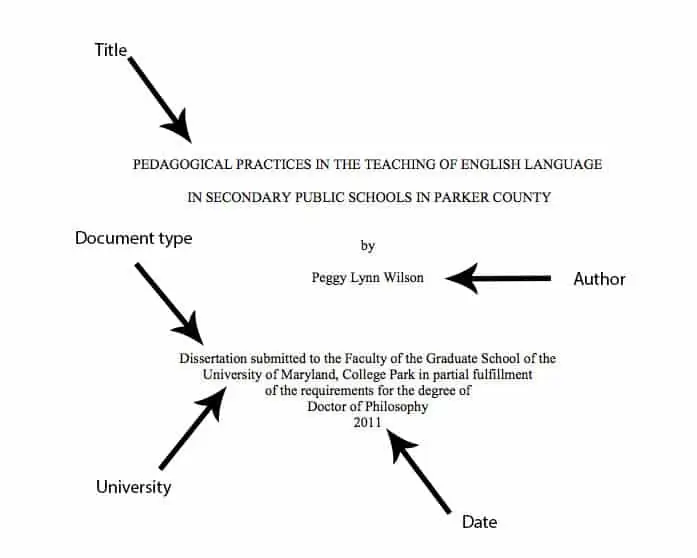
Wilson, Peggy Lynn. Pedagogical Practices in the Teaching of English Language in Secondary Public Schools in Parker County . 2011. University of Maryland, PhD dissertation.
In-text Citation Structure
(Author Last Name page #)
In-text Citation Example
(Wilson 14)
MLA Formatting Guide
MLA Formatting
- Annotated Bibliography
- Bibliography
- Block Quotes
- et al Usage
- In-text Citations
- Paraphrasing
- Page Numbers
- Sample Paper
- Works Cited
- MLA 8 Updates
- MLA 9 Updates
- View MLA Guide
Citation Examples
- Book Chapter
- Journal Article
- Magazine Article
- Newspaper Article
- Website (no author)
- View all MLA Examples
How useful was this post?
Click on a star to rate it!
We are sorry that this post was not useful for you!
Let us improve this post!
Tell us how we can improve this post?
MLA Citation Examples
Writing Tools
Citation Generators
Other Citation Styles
Plagiarism Checker
Upload a paper to check for plagiarism against billions of sources and get advanced writing suggestions for clarity and style.
Get Started
How do I cite a dissertation in MLA style?
Note: This post relates to content in the eighth edition of the MLA Handbook . For up-to-date guidance, see the ninth edition of the MLA Handbook .
A dissertation is a unique type of source. It is a finished, stand-alone work written under the auspices of an institution. In a change from the previous edition of the MLA Handbook , we do not distinguish between published and unpublished dissertations. To cite a dissertation, include in the entry the author, title, and date of publication as core elements. As an optional element, list the institution granting the degree and a description of the work.
Njus, Jesse. Performing the Passion: A Study on the Nature of Medieval Acting . 2010. Northwestern U, PhD dissertation.
If you accessed the dissertation through an online repository, include this fact as the title of the second container:
Njus, Jesse. Performing the Passion: A Study on the Nature of Medieval Acting . 2010. Northwestern U, PhD dissertation. ProQuest , search.proquest.com/docview/305212264?accountid=7432.
ProQuest™ Dissertations & Theses Citation Index
The ProQuest™ Dissertations & Theses Citation Index (PQDT) is the world's most comprehensive curated collection of multi-disciplinary dissertations and theses, offering over 5.5 million records representing dissertations and theses from thousands of universities around the world.
Extending from they early 1600s to present, PQDT coverage is broadly multidisciplinary and includes foundational research in the life sciences, mathematics, computer science, engineering, social sciences, and humanities. Within dissertations and theses is a wealth of scholarship, yet it is often overlooked because most go unpublished.
Key Features
The ProQuest Dissertations & Theses Citation Index will be a standalone database and included in an All Databases search by default. WoS users also have filter options available in each search so that they can search broadly and then narrow focus on a particular collection, subject category, document type, etc. If a user wants to locate dissertations or theses specifically, they can also search of ProQuest Dissertations & Theses Citation Index only.
Standalone and aggregated search
PQDT is included in ALL Database search and can also be searched as a unique collection.
Track citation activity in Web of Science Core Collection
Dissertations and theses that have been cited by Web of Science Core Collection records will include a citation count and a link to the citing articles.
Claim dissertation or theses to a Web of Science Researcher Profiles
Researchers can manually claim their dissertation or thesis to their Web of Science Researcher Profile and make it part of the public view of their profile.
Links to Full Text of dissertations and theses on ProQuest platform
Institutions that subscribe to PQDT Global on the ProQuest platform will be able to link directly to their entitled full text.
Note: ProQuest Dissertation and Theses Citation Index will be released to customers in two phases. Phase 1: In July 2023, ProQuest Dissertations and Theses Citation Index will go live with metadata records for 5.5+ million dissertations and theses. The records will not include cited reference indexing, which means that functionality such as Related Records and Cited References lists and associated navigation will not display. Phase 2: In late 2023, Linked Cited References lists and Related Records will be released to fully connect dissertations to the Web of Science citation network. If you have any questions regarding PQDT entitlement or functionality, please contact the Web of Science support team .
- Formatting Your Dissertation
- Introduction
Harvard Griffin GSAS strives to provide students with timely, accurate, and clear information. If you need help understanding a specific policy, please contact the office that administers that policy.
- Application for Degree
- Credit for Completed Graduate Work
- Ad Hoc Degree Programs
- Acknowledging the Work of Others
- Advanced Planning
- Dissertation Submission Checklist
- Publishing Options
- Submitting Your Dissertation
- English Language Proficiency
- PhD Program Requirements
- Secondary Fields
- Year of Graduate Study (G-Year)
- Master's Degrees
- Grade and Examination Requirements
- Conduct and Safety
- Financial Aid
- Non-Resident Students
- Registration
On this page:
Language of the Dissertation
Page and text requirements, body of text, tables, figures, and captions, dissertation acceptance certificate, copyright statement.
- Table of Contents
Front and Back Matter
Supplemental material, dissertations comprising previously published works, top ten formatting errors, further questions.
- Related Contacts and Forms
When preparing the dissertation for submission, students must follow strict formatting requirements. Any deviation from these requirements may lead to rejection of the dissertation and delay in the conferral of the degree.
The language of the dissertation is ordinarily English, although some departments whose subject matter involves foreign languages may accept a dissertation written in a language other than English.
Most dissertations are 100 to 300 pages in length. All dissertations should be divided into appropriate sections, and long dissertations may need chapters, main divisions, and subdivisions.
- 8½ x 11 inches, unless a musical score is included
- At least 1 inch for all margins
- Body of text: double spacing
- Block quotations, footnotes, and bibliographies: single spacing within each entry but double spacing between each entry
- Table of contents, list of tables, list of figures or illustrations, and lengthy tables: single spacing may be used
Fonts and Point Size
Use 10-12 point size. Fonts must be embedded in the PDF file to ensure all characters display correctly.
Recommended Fonts
If you are unsure whether your chosen font will display correctly, use one of the following fonts:
If fonts are not embedded, non-English characters may not appear as intended. Fonts embedded improperly will be published to DASH as-is. It is the student’s responsibility to make sure that fonts are embedded properly prior to submission.
Instructions for Embedding Fonts
To embed your fonts in recent versions of Word, follow these instructions from Microsoft:
- Click the File tab and then click Options .
- In the left column, select the Save tab.
- Clear the Do not embed common system fonts check box.
For reference, below are some instructions from ProQuest UMI for embedding fonts in older file formats:
To embed your fonts in Microsoft Word 2010:
- In the File pull-down menu click on Options .
- Choose Save on the left sidebar.
- Check the box next to Embed fonts in the file.
- Click the OK button.
- Save the document.
Note that when saving as a PDF, make sure to go to “more options” and save as “PDF/A compliant”
To embed your fonts in Microsoft Word 2007:
- Click the circular Office button in the upper left corner of Microsoft Word.
- A new window will display. In the bottom right corner select Word Options .
- Choose Save from the left sidebar.
Using Microsoft Word on a Mac:
Microsoft Word 2008 on a Mac OS X computer will automatically embed your fonts while converting your document to a PDF file.
If you are converting to PDF using Acrobat Professional (instructions courtesy of the Graduate Thesis Office at Iowa State University):
- Open your document in Microsoft Word.
- Click on the Adobe PDF tab at the top. Select "Change Conversion Settings."
- Click on Advanced Settings.
- Click on the Fonts folder on the left side of the new window. In the lower box on the right, delete any fonts that appear in the "Never Embed" box. Then click "OK."
- If prompted to save these new settings, save them as "Embed all fonts."
- Now the Change Conversion Settings window should show "embed all fonts" in the Conversion Settings drop-down list and it should be selected. Click "OK" again.
- Click on the Adobe PDF link at the top again. This time select Convert to Adobe PDF. Depending on the size of your document and the speed of your computer, this process can take 1-15 minutes.
- After your document is converted, select the "File" tab at the top of the page. Then select "Document Properties."
- Click on the "Fonts" tab. Carefully check all of your fonts. They should all show "(Embedded Subset)" after the font name.
- If you see "(Embedded Subset)" after all fonts, you have succeeded.
The font used in the body of the text must also be used in headers, page numbers, and footnotes. Exceptions are made only for tables and figures created with different software and inserted into the document.
Tables and figures must be placed as close as possible to their first mention in the text. They may be placed on a page with no text above or below, or they may be placed directly into the text. If a table or a figure is alone on a page (with no narrative), it should be centered within the margins on the page. Tables may take up more than one page as long as they obey all rules about margins. Tables and figures referred to in the text may not be placed at the end of the chapter or at the end of the dissertation.
- Given the standards of the discipline, dissertations in the Department of History of Art and Architecture and the Department of Architecture, Landscape Architecture, and Urban Planning often place illustrations at the end of the dissertation.
Figure and table numbering must be continuous throughout the dissertation or by chapter (e.g., 1.1, 1.2, 2.1, 2.2, etc.). Two figures or tables cannot be designated with the same number. If you have repeating images that you need to cite more than once, label them with their number and A, B, etc.
Headings should be placed at the top of tables. While no specific rules for the format of table headings and figure captions are required, a consistent format must be used throughout the dissertation (contact your department for style manuals appropriate to the field).
Captions should appear at the bottom of any figures. If the figure takes up the entire page, the caption should be placed alone on the preceding page, centered vertically and horizontally within the margins.
Each page receives a separate page number. When a figure or table title is on a preceding page, the second and subsequent pages of the figure or table should say, for example, “Figure 5 (Continued).” In such an instance, the list of figures or tables will list the page number containing the title. The word “figure” should be written in full (not abbreviated), and the “F” should be capitalized (e.g., Figure 5). In instances where the caption continues on a second page, the “(Continued)” notation should appear on the second and any subsequent page. The figure/table and the caption are viewed as one entity and the numbering should show correlation between all pages. Each page must include a header.
Landscape orientation figures and tables must be positioned correctly and bound at the top so that the top of the figure or table will be at the left margin. Figure and table headings/captions are placed with the same orientation as the figure or table when on the same page. When on a separate page, headings/captions are always placed in portrait orientation, regardless of the orientation of the figure or table. Page numbers are always placed as if the figure were vertical on the page.
If a graphic artist does the figures, Harvard Griffin GSAS will accept lettering done by the artist only within the figure. Figures done with software are acceptable if the figures are clear and legible. Legends and titles done by the same process as the figures will be accepted if they too are clear, legible, and run at least 10 or 12 characters per inch. Otherwise, legends and captions should be printed with the same font used in the text.
Original illustrations, photographs, and fine arts prints may be scanned and included, centered between the margins on a page with no text above or below.
Use of Third-Party Content
In addition to the student's own writing, dissertations often contain third-party content or in-copyright content owned by parties other than you, the student who authored the dissertation. The Office for Scholarly Communication recommends consulting the information below about fair use, which allows individuals to use in-copyright content, on a limited basis and for specific purposes, without seeking permission from copyright holders.
Because your dissertation will be made available for online distribution through DASH , Harvard's open-access repository, it is important that any third-party content in it may be made available in this way.

Fair Use and Copyright
What is fair use?
Fair use is a provision in copyright law that allows the use of a certain amount of copyrighted material without seeking permission. Fair use is format- and media-agnostic. This means fair use may apply to images (including photographs, illustrations, and paintings), quoting at length from literature, videos, and music regardless of the format.
How do I determine whether my use of an image or other third-party content in my dissertation is fair use?
There are four factors you will need to consider when making a fair use claim.
1) For what purpose is your work going to be used?
- Nonprofit, educational, scholarly, or research use favors fair use. Commercial, non-educational uses, often do not favor fair use.
- A transformative use (repurposing or recontextualizing the in-copyright material) favors fair use. Examining, analyzing, and explicating the material in a meaningful way, so as to enhance a reader's understanding, strengthens your fair use argument. In other words, can you make the point in the thesis without using, for instance, an in-copyright image? Is that image necessary to your dissertation? If not, perhaps, for copyright reasons, you should not include the image.
2) What is the nature of the work to be used?
- Published, fact-based content favors fair use and includes scholarly analysis in published academic venues.
- Creative works, including artistic images, are afforded more protection under copyright, and depending on your use in light of the other factors, may be less likely to favor fair use; however, this does not preclude considerations of fair use for creative content altogether.
3) How much of the work is going to be used?
- Small, or less significant, amounts favor fair use. A good rule of thumb is to use only as much of the in-copyright content as necessary to serve your purpose. Can you use a thumbnail rather than a full-resolution image? Can you use a black-and-white photo instead of color? Can you quote select passages instead of including several pages of the content? These simple changes bolster your fair use of the material.
4) What potential effect on the market for that work may your use have?
- If there is a market for licensing this exact use or type of educational material, then this weighs against fair use. If however, there would likely be no effect on the potential commercial market, or if it is not possible to obtain permission to use the work, then this favors fair use.
For further assistance with fair use, consult the Office for Scholarly Communication's guide, Fair Use: Made for the Harvard Community and the Office of the General Counsel's Copyright and Fair Use: A Guide for the Harvard Community .
What are my options if I don’t have a strong fair use claim?
Consider the following options if you find you cannot reasonably make a fair use claim for the content you wish to incorporate:
- Seek permission from the copyright holder.
- Use openly licensed content as an alternative to the original third-party content you intended to use. Openly-licensed content grants permission up-front for reuse of in-copyright content, provided your use meets the terms of the open license.
- Use content in the public domain, as this content is not in-copyright and is therefore free of all copyright restrictions. Whereas third-party content is owned by parties other than you, no one owns content in the public domain; everyone, therefore, has the right to use it.
For use of images in your dissertation, please consult this guide to Finding Public Domain & Creative Commons Media , which is a great resource for finding images without copyright restrictions.
Who can help me with questions about copyright and fair use?
Contact your Copyright First Responder . Please note, Copyright First Responders assist with questions concerning copyright and fair use, but do not assist with the process of obtaining permission from copyright holders.
Pages should be assigned a number except for the Dissertation Acceptance Certificate . Preliminary pages (abstract, table of contents, list of tables, graphs, illustrations, and preface) should use small Roman numerals (i, ii, iii, iv, v, etc.). All pages must contain text or images.
Count the title page as page i and the copyright page as page ii, but do not print page numbers on either page .
For the body of text, use Arabic numbers (1, 2, 3, 4, 5, etc.) starting with page 1 on the first page of text. Page numbers must be centered throughout the manuscript at the top or bottom. Every numbered page must be consecutively ordered, including tables, graphs, illustrations, and bibliography/index (if included); letter suffixes (such as 10a, 10b, etc.) are not allowed. It is customary not to have a page number on the page containing a chapter heading.
- Check pagination carefully. Account for all pages.
A copy of the Dissertation Acceptance Certificate (DAC) should appear as the first page. This page should not be counted or numbered. The DAC will appear in the online version of the published dissertation. The author name and date on the DAC and title page should be the same.
The dissertation begins with the title page; the title should be as concise as possible and should provide an accurate description of the dissertation. The author name and date on the DAC and title page should be the same.
- Do not print a page number on the title page. It is understood to be page i for counting purposes only.
A copyright notice should appear on a separate page immediately following the title page and include the copyright symbol ©, the year of first publication of the work, and the name of the author:
© [ year ] [ Author’s Name ] All rights reserved.
Alternatively, students may choose to license their work openly under a Creative Commons license. The author remains the copyright holder while at the same time granting up-front permission to others to read, share, and (depending on the license) adapt the work, so long as proper attribution is given. (By default, under copyright law, the author reserves all rights; under a Creative Commons license, the author reserves some rights.)
- Do not print a page number on the copyright page. It is understood to be page ii for counting purposes only.
An abstract, numbered as page iii , should immediately follow the copyright page and should state the problem, describe the methods and procedures used, and give the main results or conclusions of the research. The abstract will appear in the online and bound versions of the dissertation and will be published by ProQuest. There is no maximum word count for the abstract.
- double-spaced
- left-justified
- indented on the first line of each paragraph
- The author’s name, right justified
- The words “Dissertation Advisor:” followed by the advisor’s name, left-justified (a maximum of two advisors is allowed)
- Title of the dissertation, centered, several lines below author and advisor
Dissertations divided into sections must contain a table of contents that lists, at minimum, the major headings in the following order:
- Front Matter
- Body of Text
- Back Matter
Front matter includes (if applicable):
- acknowledgements of help or encouragement from individuals or institutions
- a dedication
- a list of illustrations or tables
- a glossary of terms
- one or more epigraphs.
Back matter includes (if applicable):
- bibliography
- supplemental materials, including figures and tables
- an index (in rare instances).
Supplemental figures and tables must be placed at the end of the dissertation in an appendix, not within or at the end of a chapter. If additional digital information (including audio, video, image, or datasets) will accompany the main body of the dissertation, it should be uploaded as a supplemental file through ProQuest ETD . Supplemental material will be available in DASH and ProQuest and preserved digitally in the Harvard University Archives.
As a matter of copyright, dissertations comprising the student's previously published works must be authorized for distribution from DASH. The guidelines in this section pertain to any previously published material that requires permission from publishers or other rightsholders before it may be distributed from DASH. Please note:
- Authors whose publishing agreements grant the publisher exclusive rights to display, distribute, and create derivative works will need to seek the publisher's permission for nonexclusive use of the underlying works before the dissertation may be distributed from DASH.
- Authors whose publishing agreements indicate the authors have retained the relevant nonexclusive rights to the original materials for display, distribution, and the creation of derivative works may distribute the dissertation as a whole from DASH without need for further permissions.
It is recommended that authors consult their publishing agreements directly to determine whether and to what extent they may have transferred exclusive rights under copyright. The Office for Scholarly Communication (OSC) is available to help the author determine whether she has retained the necessary rights or requires permission. Please note, however, the Office of Scholarly Communication is not able to assist with the permissions process itself.
- Missing Dissertation Acceptance Certificate. The first page of the PDF dissertation file should be a scanned copy of the Dissertation Acceptance Certificate (DAC). This page should not be counted or numbered as a part of the dissertation pagination.
- Conflicts Between the DAC and the Title Page. The DAC and the dissertation title page must match exactly, meaning that the author name and the title on the title page must match that on the DAC. If you use your full middle name or just an initial on one document, it must be the same on the other document.
- Abstract Formatting Errors. The advisor name should be left-justified, and the author's name should be right-justified. Up to two advisor names are allowed. The Abstract should be double spaced and include the page title “Abstract,” as well as the page number “iii.” There is no maximum word count for the abstract.
- The front matter should be numbered using Roman numerals (iii, iv, v, …). The title page and the copyright page should be counted but not numbered. The first printed page number should appear on the Abstract page (iii).
- The body of the dissertation should be numbered using Arabic numbers (1, 2, 3, …). The first page of the body of the text should begin with page 1. Pagination may not continue from the front matter.
- All page numbers should be centered either at the top or the bottom of the page.
- Figures and tables Figures and tables must be placed within the text, as close to their first mention as possible. Figures and tables that span more than one page must be labeled on each page. Any second and subsequent page of the figure/table must include the “(Continued)” notation. This applies to figure captions as well as images. Each page of a figure/table must be accounted for and appropriately labeled. All figures/tables must have a unique number. They may not repeat within the dissertation.
- Any figures/tables placed in a horizontal orientation must be placed with the top of the figure/ table on the left-hand side. The top of the figure/table should be aligned with the spine of the dissertation when it is bound.
- Page numbers must be placed in the same location on all pages of the dissertation, centered, at the bottom or top of the page. Page numbers may not appear under the table/ figure.
- Supplemental Figures and Tables. Supplemental figures and tables must be placed at the back of the dissertation in an appendix. They should not be placed at the back of the chapter.
- Permission Letters Copyright. permission letters must be uploaded as a supplemental file, titled ‘do_not_publish_permission_letters,” within the dissertation submission tool.
- DAC Attachment. The signed Dissertation Acceptance Certificate must additionally be uploaded as a document in the "Administrative Documents" section when submitting in Proquest ETD . Dissertation submission is not complete until all documents have been received and accepted.
- Overall Formatting. The entire document should be checked after all revisions, and before submitting online, to spot any inconsistencies or PDF conversion glitches.
- You can view dissertations successfully published from your department in DASH . This is a great place to check for specific formatting and area-specific conventions.
- Contact the Office of Student Affairs with further questions.
CONTACT INFO
Katie riggs, explore events.
- Plagiarism and grammar
- Citation guides
Cite a Dissertation in ART-HISTORY

Don't let plagiarism errors spoil your paper
Consider your source's credibility. ask these questions:, contributor/author.
- Has the author written several articles on the topic, and do they have the credentials to be an expert in their field?
- Can you contact them? Do they have social media profiles?
- Have other credible individuals referenced this source or author?
- Book: What have reviews said about it?
- What do you know about the publisher/sponsor? Are they well-respected?
- Do they take responsibility for the content? Are they selective about what they publish?
- Take a look at their other content. Do these other articles generally appear credible?
- Does the author or the organization have a bias? Does bias make sense in relation to your argument?
- Is the purpose of the content to inform, entertain, or to spread an agenda? Is there commercial intent?
- Are there ads?
- When was the source published or updated? Is there a date shown?
- Does the publication date make sense in relation to the information presented to your argument?
- Does the source even have a date?
- Was it reproduced? If so, from where?
- If it was reproduced, was it done so with permission? Copyright/disclaimer included?
- Citation Machine® Plus
- Citation Guides
- Chicago Style
- Harvard Referencing
- Terms of Use
- Global Privacy Policy
- Cookie Notice
- DO NOT SELL MY INFO
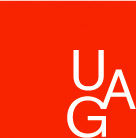
- Opportunities
- Critical Aesthetics
- Art Program
- Publications
Department of Art presents the M.F.A. Thesis Exhibitions 2024
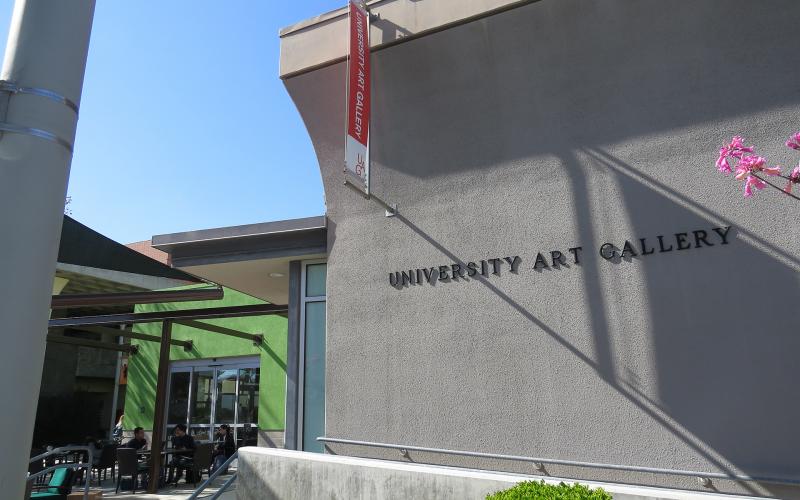
The UC Irvine Claire Trevor School of the Arts Department of Art proudly announces the opening of the 2024 M.F.A. thesis exhibitions, showcasing the culmination of three years of intensive study and creative exploration by its graduate candidates.
Under the guidance of a globally acclaimed faculty, the graduate program at UC Irvine offers a dynamic and interdisciplinary platform for visual arts education. The program comprising a comprehensive curriculum of core and elective classes in production, theory, and contemporary issues, the program fosters both creative and critical development among its students. This ethos is further enriched by the university's status as a leading research institution, allowing graduate students to access courses across various departments and programs, enhancing their academic experience.
The 2024 M.F.A. thesis exhibitions present the solo works of the following candidates:
- Alberto Lule
- Gintautė Skvernytė
- Joshua Thomen
- Lauren Goldenberg Longoria
- Liz Stringer
- Devin Wilson
The exhibitions are divided into two rounds, with the first featuring Alberto Lule, Gintautė Skvernytė, Joshua Thomen, and Mona Welch. Please join the department for an opening reception for "Part 1" on Saturday, April 20, from 2 to 5 p.m. "Part 2" will showcase the works of Lauren Goldenberg Longoria, Liz Stringer, and Devin Wilson, with their opening reception scheduled for Saturday, May 11, from 2 to 5 p.m.
These exhibitions not only highlight the artistic achievements of the M.F.A. candidates but also underscore the Department of Art's commitment to nurturing creative excellence and fostering a vibrant intellectual community.
Read further to learn more about the artists and their work. Both exhibitions will be held at the Contemporary Arts Center Gallery, University Art Gallery and Room Galler. Admission is free and open to the public.
M.F.A. Thesis Exhibitions, Part 1 April 20 – May 4, 2024 Opening: Saturday, April 20 from 2–5 p.m.
Alberto Lule | Displacement Erratic Examines the displacement of the body through various systems. Artworks attempt to find connections between overlooked systems of power, often seen as unrelated.
Gintautė Skvernytė | Switch Works shown: Paraffin Slides, Flicks (contact prints), Still, and a character named Sugar.
Joshua Thomen | On a Particularly Windy Day This latest exhibition of sculptures deepens a sense of animacy within the decorative, ephemeral, and unseen. Disparate ways of working come together to weave a quiet and wistful poem.
Mona Welch | 7 Paintings for Spring A yellow painting, a blue painting, three brown paintings, a red painting, and a beige one.
M.F.A. Thesis Exhibitions, Part 2 May 11 – 25, 2024 Opening: Saturday, May 11 from 2–5 p.m.
Lauren Goldenberg Longoria | Sweet Spit Lauren Goldenberg Longoria’s paintings are vulnerable meditations of material, memory, and time. Rooted in a spirit of cannibalizing, Sweet Spit considers how her papermaking process simultaneously relates to the body, nostalgic objects in her grandmother’s home, and the compulsive desire to squeeze what’s oozing. These compact paper works are sympathetic to eachother in how they scaffold, disguise, and unearth.
Liz Stringer | The Showings Horror is the allure of the forbidden, and what is more forbidden than a body? The Showings is a sculptural procession of amalgamated ceramic, steel, copper, and resin that compound to articulate a body in various stages of protection and metamorphosis. Within this material drama, this existential narrative navigates the various ways in which monstrosity reveals a cultural understanding of a body and its corporeal dread.
Devin Wilson | The Pigeon Has Landed The Pigeon Has Landed explores the pigeon as the symbolic nexus of capitalism. Serving as both a reflection on obsolete technology in delivery services and an exploration of pigeons as agents of militarized spying, the project confronts the whimsical yet unsettling conspiracy theory that posits "Birds Aren't Real." Through the use of digital fabrication and advanced engineering processes, the work in the exhibition explores the satirical nature of internet meme culture which produces, replicates, and disseminates fictional narratives and misinformation.
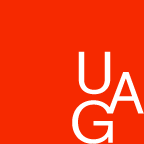
University Art Gallery | 712 Arts Plaza CAC Gallery | Contemporary Arts Center | Bldg 721 Room Gallery | Art Culture and Technology | Bldg 727
Gallery Hours: Tuesday–Saturday | 12–6pm Email: [email protected] Please follow @uag_ucirvine on Instagram or visit www.uag.arts.uci.edu
Media Contact: Sasha Ussef, Associate Director [email protected]
Parking: Mesa Parking Structure 4002 Mesa Road, Irvine, CA 92617 Price: $15/day or $4/hr After turning onto Mesa Road, take the second right and drive towards the first floor kiosk of the parking structure. Or take a right at the first stop sign to pass through the second floor kiosk. If there is no attendant stationed, visit parking.uci.edu/pay and enter the code 3M270 to register your vehicle. Please park in an unmarked spot. The third floor is the most ideal, but any floor can be parked on. Cross the bridge that attaches from the third floor to the Art Courtyard.
Vital Condition: 2024 BFA Thesis Exhibition
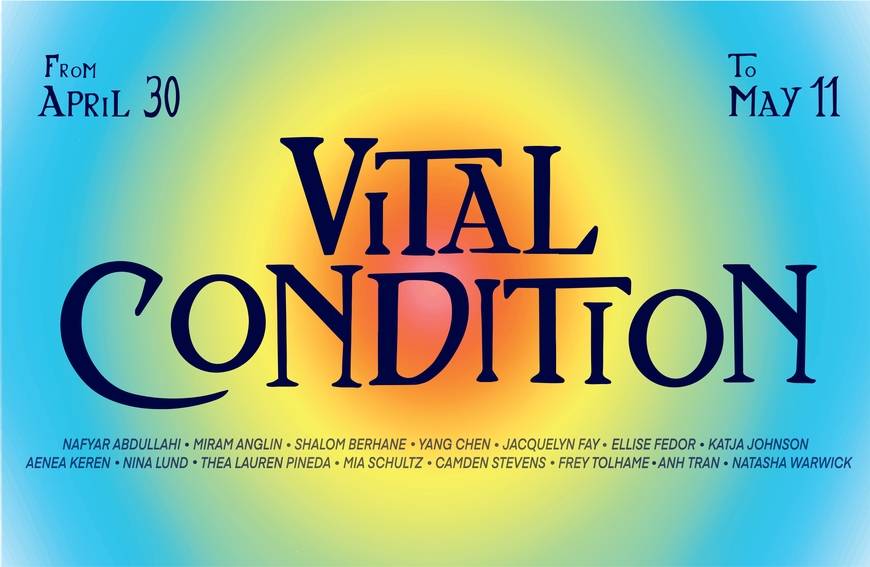
Vital Condition
April 30 - may 11, 2024, katherine e. nash gallery.
Thursday, May 2: Public Program | 6:00 - 7:00 PM Reception | 7:00 - 9:00 PM Outdoors at the Regis Center for ArtGallery hours: Tuesday – Saturday, 11:00 AM – 5:00 PM
The Katherine E. Nash Gallery at the University of Minnesota is proud to present Vital Condition , the BFA thesis exhibition, featuring the work of Nafyar Abdullahi, Miram Anglin, Shalom Berhane, Yang Chen, Jacquelyn Fay, Ellise Fedor, Katja Johnson, Aenea Keren, Nina Lund, Thea Lauren Pineda, Mia Schultz, Sam Steine, Camden Stevens, Frey Tolhame, Anh Tran, and Natasha Warwick.
Thursday, May 2, 6:00-9:00 PM Public Program | 6:00 - 7:00 PM Reception | 7:00 - 9:00 PM Outdoors at the Regis Center for Art
Join us for a joint program from 6:00-7:00 pm for the BFA and BA Spring Class of 2024, followed by a reception with light refreshments from 7:00-9:00 PM, rain or shine, outdoors at the Regis Center for Art. That same evening visit the student curated exhibition, Temporal Exchange , in the Quarter Gallery.
The Katherine E. Nash Gallery spans 5,000 square feet for the presentation of exhibitions and related programming that engage with a wide range of artists, scholars, and collaborative partners.
Location Regis Center for Art (East) 405 21st Avenue South Minneapolis, MN 55455
Gallery Hours Tuesday - Saturday, 11 am – 5 pm
The Regis Center for Art is locked to the public on Saturdays, with U-card access only. Visitors can call 612-624-7530 to gain entrance into the galleries and should plan to enter the building's main entrance located on 21st Avenue South directly across from the parking garage.
Contact Us [email protected] 612-624-7530
Parking & Public Transit Learn more about the parking options below : 21st Avenue South ramp 5th Street South lot 19th Avenue South ramp
Hourly metered parking is available nearby on 22nd Avenue South and Locust Street . The gallery is accessible via Metro Transit buses and light rail lines. For your best route, visit Metro Transit Trip Planner .
Accessibility Regis Center for Art is accessible to visitors who use mobility devices or prefer to avoid stairs. Service animals are welcome in the gallery.
A fully accessible, gender neutral restroom is available on the 2nd floor of the Regis Center for Art (West). To access this restroom, take the elevator to the 2nd floor and proceed across the skyway towards Regis West. As you exit the skyway the restroom will be directly across from you. Fully accessible gendered restrooms are located directly to the left hand side when exiting the gallery on the first floor of Regis Center for Art (East).
Large bags and backpacks must be left at the gallery front desk with the attendant. In order to protect the art, no food or drink is allowed in the gallery.
Related News
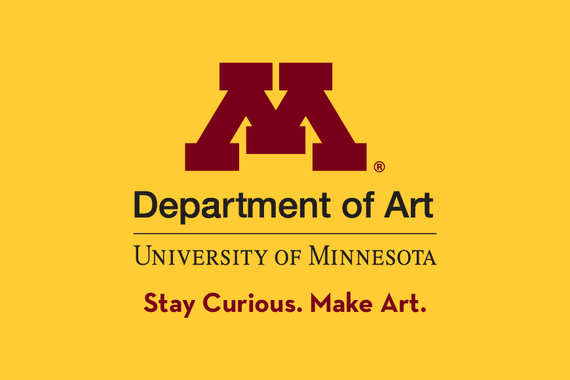
Art News + Happenings
Check out the latest Art News + Happenings e-newsletter! Subscribe for news and opportunities every Tuesday afternoon.
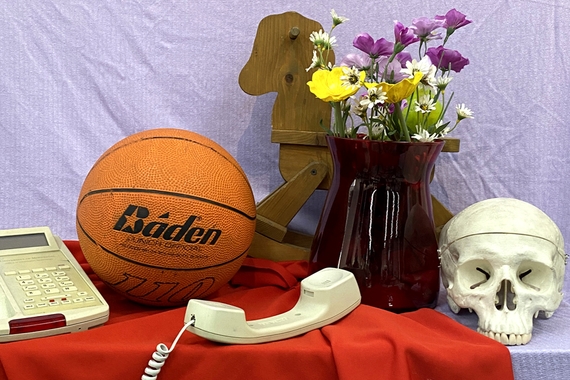
What Makes A Good Still Life?
Students in several Intro to Painting classes take on an age-old subject: weird collections of things on a table.
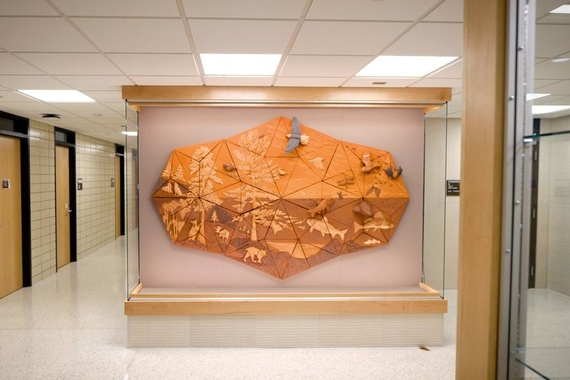
MFA Alum Anna Metcalfe installs permanent ceramic sculpture at UMN-Duluth
"Reliquaries of the North" celebrates the biodiversity of Minnesota’s North Shore region.
More Art News
Finishing Touches
Visual Arts Majors Thesis Exhibition
Posted in: Announcements
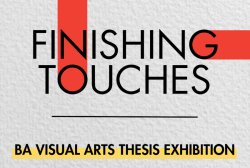
Celebrate the accomplishments of our Visual Arts majors in this vibrant thesis exhibition, the capstone of their BA Degree. Finishing Touches is a collective exhibition reflecting the diverse viewpoints of 32 rising graduates. This showcase represents the culmination of their cross-disciplinary research in art. This exhibition will be held in Finley Gallery & Calcia 207 from May 2nd to May 8th with an opening reception on May 3rd from 6pm to 8pm.
Each student presents a cohesive body of work, offering fresh perspectives through a range of media and approaches. Come visit the galleries and connect with their paintings, room-sized installations, crafted sculptures, prints, and photography on display throughout Finley Gallery and first-floor exhibition spaces in Finley Hall, and also in Calcia Hall 207. We invite you to spend time with the critical themes explored in this exciting display of capstone projects.
Featured Artists:
SECTION 1 Deborah Akingbala, Joanna Benito Rosas, Kelsie Black, Nina Bogaenko, Meghan Brennan, Dylan Danuser, Veronica Enny, Brenna Frawley, Emma Hands, LaChelle Harris, Grace La Vergne, Rayjan Luly, Vanessa Marone, Jennifer Melendres, Fatima Peguero, Sean Santos
SECTION 2 Kenia Akridge, Thomas Brockman, Jenna Bukowski, Josh Dela Cruz, Francesca Esposito, Philip Esquite, Mike Ezpeleta, Aaliyah Mancero, Kain Orsini, Kevin Pineros, Giannie Rodriguez, Ethan Shluper, Wolfgang Smith, Jenifer Szuba, Karolina Tejada, Jahné Williams
- F inishing Touches
- BA Visual Arts Thesis Exhibition
- On view: May 2 – May 8, 2024
- Reception: Friday, May 3, 2024, 6:00 – 8:00 pm
- Location: Finley Gallery, Annex, 1st floor galleries, & Calcia 207
- Light refreshments will be served
- Gallery Hours: Mon-Fri 10-8pm, Sat 10-3pm
Purdue Online Writing Lab Purdue OWL® College of Liberal Arts
MLA Works Cited: Other Common Sources

Welcome to the Purdue OWL
This page is brought to you by the OWL at Purdue University. When printing this page, you must include the entire legal notice.
Copyright ©1995-2018 by The Writing Lab & The OWL at Purdue and Purdue University. All rights reserved. This material may not be published, reproduced, broadcast, rewritten, or redistributed without permission. Use of this site constitutes acceptance of our terms and conditions of fair use.
Several sources have multiple means for citation, especially those that appear in varied formats: films, DVDs, television shows, music, published and unpublished interviews, interviews over e-mail, published and unpublished conference proceedings. The following section discusses these sorts of citations as well as others not covered in the print, periodical, and electronic sources sections.
Use the following format for all sources:
Author. Title. Title of container (self contained if book), Other contributors (translators or editors), Version (edition), Number (vol. and/or no.), Publisher, Publication Date, Location (pages, paragraphs URL or DOI). 2 nd container’s title, Other contributors, Version, Number, Publisher, Publication date, Location, Date of Access (if applicable).
An Interview
Interviews typically fall into two categories: print or broadcast published and unpublished (personal) interviews, although interviews may also appear in other, similar formats such as in e-mail format or as a Web document.
Personal Interviews
Personal interviews refer to those interviews that you conduct yourself. List the interview by the name of the interviewee. Include the descriptor Personal interview and the date of the interview.
Smith, Jane. Personal interview. 19 May 2014.
Published Interviews (Print or Broadcast)
List the interview by the full name of the interviewee. If the name of the interview is part of a larger work like a book, a television program, or a film series, place the title of the interview in quotation marks and place the title of the larger work in italics. If the interview appears as an independent title, italicize it. For books, include the author or editor name after the book title.
Note: If the interview from which you quote does not feature a title, add the descriptor, Interview by (unformatted) after the interviewee’s name and before the interviewer’s name.
Gaitskill, Mary. Interview with Charles Bock. Mississippi Review , vol. 27, no. 3, 1999, pp. 129-50.
Amis, Kingsley. “Mimic and Moralist.” Interviews with Britain’s Angry Young Men , By Dale Salwak, Borgo P, 1984.
Online-only Published Interviews
List the interview by the name of the interviewee. If the interview has a title, place it in quotation marks. Cite the remainder of the entry as you would other exclusive web content. Place the name of the website in italics, give the publisher name (or sponsor), the publication date, and the URL.
Note: If the interview from which you quote does not feature a title, add the descriptor Interview by (unformatted) after the interviewee’s name and before the interviewer’s name.
Zinkievich, Craig. Interview by Gareth Von Kallenbach. Skewed & Reviewed , 27 Apr. 2009, www.arcgames.com/en/games/star-trek-online/news/detail/1056940-skewed-%2526-reviewed-interviews-craig. Accessed 15 May 2009.
Speeches, Lectures, or Other Oral Presentations (including Conference Presentations)
Start with speaker’s name. Then, give the title of the speech (if any) in quotation marks. Follow with the title of the particular conference or meeting and then the name of the organization. Name the venue and its city (if the name of the city is not listed in the venue’s name). Use the descriptor that appropriately expresses the type of presentation (e.g., Address, Lecture, Reading, Keynote Speech, Guest Lecture, Conference Presentation).
Stein, Bob. “Reading and Writing in the Digital Era.” Discovering Digital Dimensions, Computers and Writing Conference, 23 May 2003, Union Club Hotel, West Lafayette, IN. Keynote Address.
Panel Discussions and Question-and-Answer Sessions
The MLA Handbook makes a distinction between the formal, rehearsed portion of a presentation and the informal discussion that often occurs after. To format an entry for a panel discussion or question-and-answer session, treat the panel members or speakers as authors by listing them first. If these people are formally listed as panelists, indicate this by following their names with a comma and the title "panelist(s)." Follow with the title of the discussion, or, if there is no title, a simple description. In the latter case, don't capitalize the description. Follow this with the title of the conference or event. End with the date and the location.
Bavis, Jim and Stein, Tammi, panelists. Panel discussion. Dawn or Doom Conference, 4 Nov. 2018, Stewart Hall, Purdue University, West Lafayette, IN.
Treat recorded discussions as instances of the appropriate medium (e.g., if you want to cite a recording of a panel discussion hosted on YouTube, cite it the same way you would cite an ordinary online video ).
Published Conference Proceedings
Cite published conference proceedings like a book. If the date and location of the conference are not part of the published title, add this information after the published proceedings title.
Last Name, First Name, editor. Conference Title , Conference Date and Location, Publisher, Date of Publication.
To cite a presentation from published conference proceedings, begin with the presenter’s name. Place the name of the presentation in quotation marks. Follow with publication information for the conference proceedings.
Last Name, First Name. “Conference Paper Title.” Conference Title that Includes Conference Date and Location , edited by Conference Editor(s), Publisher, Date of Publication.
A Painting, Sculpture, or Photograph
Provide the artist's name, the title of the artwork in italics, and the date of composition. Finally, provide the name of the institution that houses the artwork followed by the location of the institution (if the location is not listed in the name of the institution, e.g. The Art Institute of Chicago).
Goya, Francisco. The Family of Charles IV . 1800, Museo del Prado, Madrid.
If the medium and/or materials (e.g., oil on canvas) are important to the reference, you can include this information at the end of the entry. However, it is not required.
For photographic reproductions of artwork (e.g. images of artwork in a book), treat the book or website as a container. Remember that for a second container, the title is listed first, before the contributors. Cite the bibliographic information as above followed by the information for the source in which the photograph appears, including page or reference numbers (plate, figure, etc.).
Goya, Francisco. The Family of Charles IV . 1800, Museo del Prado, Madrid. Gardener's Art Through the Ages , 10 th ed., by Richard G. Tansey and Fred S. Kleiner, Harcourt Brace, p. 939.
If you viewed the artwork on the museum's website, treat the name of the website as the container and include the website's publisher and the URL at the end of the citation. Omit publisher information if it is the same as the name of the website. Note the period after the date below, rather than the comma: this is because the date refers to the painting's original creation, rather than to its publication on the website. Thus, MLA format considers it an "optional element."
Goya, Francisco. The Family of Charles IV . 1800 . Museo del Prado, museodelprado.es/en/the-collection/art-work/the-family-of-carlos-iv/f47898fc-aa1c-48f6-a779-71759e417e74.
A Song or Album
Music can be cited multiple ways. Mainly, this depends on the container that you accessed the music from. Generally, citations begin with the artist name. They might also be listed by composers or performers. Otherwise, list composer and performer information after the album title. Put individual song titles in quotation marks. Album names are italicized. Provide the name of the recording manufacturer followed by the publication date.
If information such as record label or name of album is unavailable from your source, do not list that information.
Morris, Rae. “Skin.” Cold, Atlantic Records, 2014. Spotify , open.spotify.com/track/0OPES3Tw5r86O6fudK8gxi.
Online Album
Beyoncé. “Pray You Catch Me.” Lemonade, Parkwood Entertainment, 2016, www.beyonce.com/album/lemonade-visual-album/.
Nirvana. "Smells Like Teen Spirit." Nevermind , Geffen, 1991.
Films or Movies
List films by their title. Include the name of the director, the film studio or distributor, and the release year. If relevant, list performer names after the director's name.
Speed Racer . Directed by Lana Wachowski and Lilly Wachowski, performances by Emile Hirsch, Nicholas Elia, Susan Sarandon, Ariel Winter, and John Goodman, Warner Brothers, 2008.
To emphasize specific performers or directors, begin the citation with the name of the desired performer or director, followed by the appropriate title for that person.
Lucas, George, director. Star Wars Episode IV: A New Hope . Twentieth Century Fox, 1977.
Television Shows
Recorded Television Episodes
Cite recorded television episodes like films (see above). Begin with the episode name in quotation marks. Follow with the series name in italics. When the title of the collection of recordings is different than the original series (e.g., the show Friends is in DVD release under the title Friends: The Complete Sixth Season), list the title that would help researchers to locate the recording. Give the distributor name followed by the date of distribution.
"The One Where Chandler Can't Cry." Friends: The Complete Sixth Season , written by Andrew Reich and Ted Cohen, directed by Kevin Bright, Warner Brothers, 2004.
Broadcast TV or Radio Program
Begin with the title of the episode in quotation marks. Provide the name of the series or program in italics. Also include the network name, call letters of the station followed by the date of broadcast and city.
"The Blessing Way." The X-Files . Fox, WXIA, Atlanta, 19 Jul. 1998.
Netflix, Hulu, Google Play
Generally, when citing a specific episode, follow the format below.
“94 Meetings.” Parks and Recreation, season 2, episode 21, NBC, 29 Apr. 2010. Netflix, www.netflix.com/watch/70152031.
An Entire TV Series
When citing the entire series of a TV show, use the following format.
Daniels, Greg and Michael Schur, creators. Parks and Recreation . Deedle-Dee Productions and Universal Media Studios, 2015.
A Specific Performance or Aspect of a TV Show
If you want to emphasize a particular aspect of the show, include that particular information. For instance, if you are writing about a specific character during a certain episode, include the performer’s name as well as the creator’s.
“94 Meetings.” Parks and Recreation, created by Greg Daniels and Michael Schur, performance by Amy Poehler, season 2, episode 21, Deedle-Dee Productions and Universal Media Studios, 2010.
If you wish to emphasize a particular character throughout the show’s run time, follow this format.
Poehler, Amy, performer. Parks and Recreation. Deedle-Dee Productions and Universal Media Studios, 2009-2015.
Begin with the title of the episode in quotation marks. Provide the name of the series in italics. Then follow with MLA format per usual.
“Best of Not My Job Musicians.” Wait Wait…Don’t Tell Me! from NPR, 4 June 2016, www.npr.org/podcasts/344098539/wait-wait-don-t-tell-me.
Spoken-Word Albums such as Comedy Albums
Treat spoken-word albums the same as musical albums.
Hedberg, Mitch. Strategic Grill Locations . Comedy Central, 2003.
Digital Files (PDFs, MP3s, JPEGs)
Determine the type of work to cite (e.g., article, image, sound recording) and cite appropriately. End the entry with the name of the digital format (e.g., PDF, JPEG file, Microsoft Word file, MP3). If the work does not follow traditional parameters for citation, give the author’s name, the name of the work, the date of creation, and the location.
Beethoven, Ludwig van. Moonlight Sonata . Crownstar, 2006.
Smith, George. “Pax Americana: Strife in a Time of Peace.” 2005. Microsoft Word file.
Council of Writing Program Administrators, National Council of Teachers of English, and National Writing Project. Framework for Success in Postsecondary Writing . CWPA, NCTE, and NWP, 2011, wpacouncil.org/files/framework-for-success-postsecondary-writing.pdf.
Bentley, Phyllis. “Yorkshire and the Novelist.” The Kenyon Review , vol. 30, no. 4, 1968, pp. 509-22. JSTOR , www.jstor.org.iii/stable/4334841.
Discover the Arts
- Arizona Arts
- Arizona Arts Live
- Center for Creative Photography
- University of Arizona Museum of Art
- College of Fine Arts
- School of Art
- School of Dance
- Fred Fox School of Music
- School of Theatre, Film & Television
- Hours, Admission, Directions
- Group Visits
- Accessibility
- Know Before You Go
- Exhibitions
- Newsletter Signup
- Mobile Guide
- Search the Collection
- Become a Member
- Ways to Give
- Work With Us
- Mission + Vision
- Woman-Ochre’s Journey
- Collections
- Join + Give
Contact Info
We believe in the power of art to spark essential conversations and enhance research at our university and in our community.
Educational programs designed to help you learn more about and enjoy art.
Experiences that expose you to beautiful and inspiring works of art.
Gain access to exclusive exhibitions, events, and behind-the-scenes tours.
Closing Reception: 2024 MFA Thesis Exhibition

- Closing Reception: 2024 M...
Meet this year's MFA students and glimpse the future of visual art!
Join the University of Arizona Museum of Art and School of Art in celebrating the 2024 Master of Fine Arts Thesis Exhibition . The reception is free and open to the public, and refreshments will be served.
This exhibition is the culmination of the Master of Fine Arts Studio Degree and is presented during a graduate student’s final semester in the program. During the last year of their coursework, graduates work closely with faculty to develop a body of original art to present to the public in lieu of a written thesis.
The end result offers visitors the opportunity to see new, cutting-edge art in a variety of mediums and styles.
With questions about access or to request any disability-related accommodations at this event — such as ASL interpreting, closed-captioning, wheelchair access, or electronic text, etc. — please contact Visitor & Member Services Lead Myriam Sandoval , 520-626-2087.
Related Exhibition
April 13, 2024 through May 11, 2024
2024 MFA Thesis

Join UAMA and gain access to exclusive exhibitions, events, behind-the-scenes tours, and other exclusive benefits.
Support exhibitions, educational programs, acquisitions, archives, public art and enhancement of the Museum’s general operations.
Help | Advanced Search
Computer Science > Robotics
Title: innovative integration of visual foundation model with a robotic arm on a mobile platform.
Abstract: In the rapidly advancing field of robotics, the fusion of state-of-the-art visual technologies with mobile robotic arms has emerged as a critical integration. This paper introduces a novel system that combines the Segment Anything model (SAM) -- a transformer-based visual foundation model -- with a robotic arm on a mobile platform. The design of integrating a depth camera on the robotic arm's end-effector ensures continuous object tracking, significantly mitigating environmental uncertainties. By deploying on a mobile platform, our grasping system has an enhanced mobility, playing a key role in dynamic environments where adaptability are critical. This synthesis enables dynamic object segmentation, tracking, and grasping. It also elevates user interaction, allowing the robot to intuitively respond to various modalities such as clicks, drawings, or voice commands, beyond traditional robotic systems. Empirical assessments in both simulated and real-world demonstrate the system's capabilities. This configuration opens avenues for wide-ranging applications, from industrial settings, agriculture, and household tasks, to specialized assignments and beyond.
Submission history
Access paper:.
- HTML (experimental)
- Other Formats
References & Citations
- Google Scholar
- Semantic Scholar
BibTeX formatted citation
Bibliographic and Citation Tools
Code, data and media associated with this article, recommenders and search tools.
- Institution
arXivLabs: experimental projects with community collaborators
arXivLabs is a framework that allows collaborators to develop and share new arXiv features directly on our website.
Both individuals and organizations that work with arXivLabs have embraced and accepted our values of openness, community, excellence, and user data privacy. arXiv is committed to these values and only works with partners that adhere to them.
Have an idea for a project that will add value for arXiv's community? Learn more about arXivLabs .
- All Graduate Programs
- Doctoral Degree Programs
- Master's Degree Programs
- Dual Bachelor's/Master's Degrees
- Postbaccalaureate Programs
- Special Students (Non-Degree)
- Meet Our Faculty
- Apply Online
- Frequently Asked Questions
- Application Fees
- Admitted Students
- Request Information
- Diversity at GSAS
- International Applicants
- Visiting Brandeis and Waltham
- Cost of Attendance Calculator
- Financial Aid
- Aid for Master's Students
- Alum Scholarship
- Institute for the Recruitment of Teachers Scholarship
- Veterans Benefits
- Aid for Doctoral Students
- Stipend Information
- DEIS Scholarship
- Aid for Postbaccalaureate Students
- How to Apply For Loans
- Step-By-Step: Applying for a Federal Direct Loan
- Frequently Asked Questions: Federal Direct Loans
- Step-by-Step: Applying for a Graduate PLUS Loan
- Frequently Asked Questions: Graduate PLUS Loans
- Alternative Loan Options
- News and Events
- Latest News
- Professional Development Series
- Upcoming Events
- Newsletters
- Student Resources
- Wellness Resources
- Student Employment
- Student Government
- Academic Resources
- GSAS Policies and Procedures
- Readmission
- Information for Incoming Students 2023
- Completing Your Program
- Staff Directory By Subject
- Teaching Opportunities with Undergraduates
- University Prize Instructorship
- Teaching Opportunities: Off-Campus and With Other Communities
- Graduate Student Teaching Awards
- Awards for Master's Students
- Awards for PhD Students
- Fellowships and Grants
- GSAS Fellowship and Grant Recipients
- Publications, Presentations, and Performances
- Graduate Student Appreciation Week - 2024
- Summer 2024 Funding and Professional Development
- Commencement
- Graduate School of Arts and Sciences Dean's Mentoring Award Nominations
- Professional Development
- One-on-One Career Consultations
- Past Career Seminar Recordings
- Job Search Resources
- Brandeis Alumni Career Paths
- Three Minute Thesis (3MT)
- Career Fellows Program
- Get Funding
- Program Overview
- Information for Students
- Information for Faculty
- Staff Directory by Subject
- Our Stories
- GSAS Couples
- Our Scholarship
- Program Celebrations
- Favorite Memories
- Brandeis 75th Anniversary
- Dean's Priorities
- Dean's Cabinet
- Alumni Career Paths
- Resources, Policies, and Procedures for Faculty and Staff
- Graduate Council
- Donate to GSAS

Brandeis combines the resources of a world-class research university with the personal attention of a liberal arts setting. The Graduate School of Arts and Sciences offers 17 doctoral programs and more than 40 master's and postbaccalaureate programs.

One of the key differences at the Graduate School of Arts and Sciences is our emphasis on interdisciplinary learning. You will learn the importance of connecting with people who have a broad range of expertise and experience.
- How to Apply for Loans

We support all doctoral students and the majority of master’s and post-baccalaureate students who maintain satisfactory academic progress with loans and scholarships.

Keep up to date with the latest news and events from the Graduate School of Arts and Sciences.
- Student Life
- Academic Resources and Policies
- Teaching Opportunities and Resources
- Conference and Research Awards
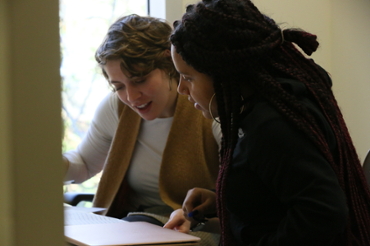
Find important resources and information to help you succeed as a GSAS student.
- Events and Career Seminars
- The Connected PhD

Professional development at GSAS is for PhD and MA students in all departments and in all stages of their career. Whether you are just starting or are about to finish your degree, the resources we provide are for you. Our goal is to enable students to pursue fulfilling careers in the private sector, academia, non-profits and government.
- GSAS 70th Anniversary
- GSAS Alumni
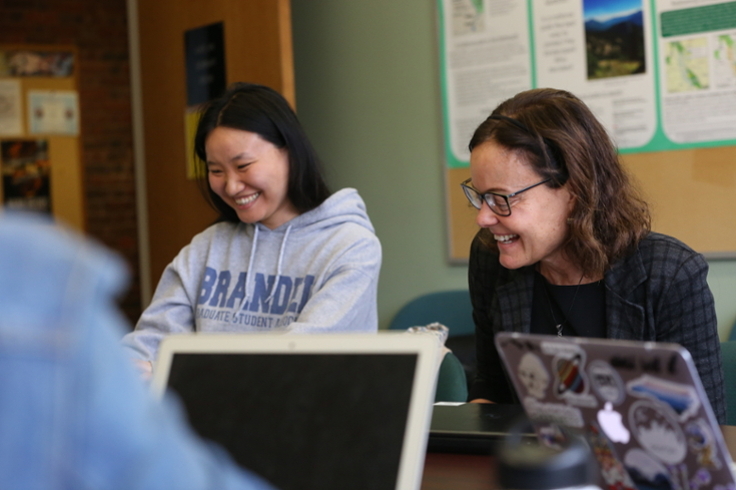
Find a member of staff who can address your questions. Meet your Graduate Department Representative and your Director of Graduate Study.
Graduate School of Arts and Sciences
Gsas students shine in 2024 three minute thesis competition.
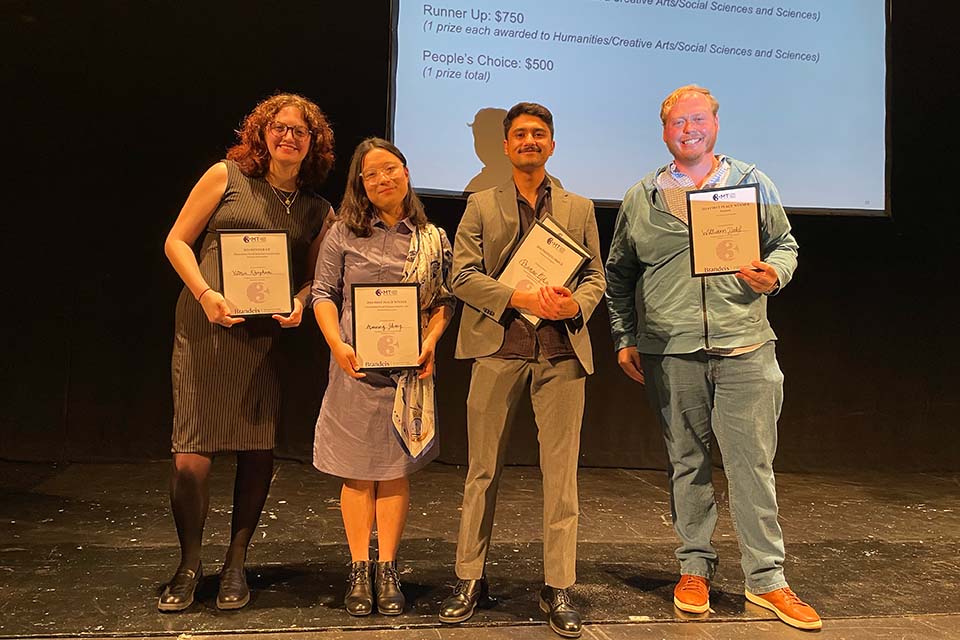
April 30, 2024
Ayla Cordell | Graduate School of Arts and Sciences
The 2024 Three Minute Thesis Competition (3MT) at Brandeis Graduate School of Arts & Sciences was not Will Dahl’s first rodeo. “It took me two tries,” the Molecular and Cell Biology PhD student said. “On my first attempt last year, I missed a line and stood silent for what felt like ages. To be honest, I was terrified!” This year, Will took home the first place prize for the Sciences of $1,000 and the overall win. He credits his success to careful planning, refinement, and lots of practice. He focused on formatting his talk as a story that would resonate with a wide audience: “Every sentence must be calibrated to communicate, and there is no room for asides. The talk converges from broader impacts to the actual thesis.”
Explaining your research in just three minutes is a tall order, but on April 5, the third annual 3MT Competition, founded by the University of Queensland , saw ten GSAS students meet that very task. Marika McCann, Associate Director of Professional Development at GSAS and member of the 3MT team, alongside Associate Professor of Anthropology and Faculty Director of Professional Development Jon Anjaria; Anahita Zare of MRSEC ; and Becky Prigge, Assistant Dean of Student Affairs at GSAS, said this about the 2024 competitors: “Our team was very impressed with how hard our students worked and the overall enthusiasm they brought to their talks. The audience learned so much from our students in this short time, including the possibility of early detection of Parkinson’s Disease, the importance of examining circadian rhythms, patterns in Honduran ceramics, and Tamil transfeminine performance in post-war Sri Lanka.”
Under the bright white stage lights and looking out upon an audience of friends, family, members of the Brandeis community, and a panel of five judges, finalists took to the Spingold Theatre stage. While it was certainly nerve-wracking, contestants noted the benefits of presenting in this format.
Manning Zhang, who won first place in the Humanities/Creative Arts/Social Sciences category, said the best moment of the competition was standing on the stage for the final round with rushing adrenaline. Acknowledging that few friends and family know about what she researches in Sociology and Health Policy, she began sharing more with them to understand how different people would react to her research. While this helped her prepare for the competition, it ended up holding deeper meaning for Zhang: “It took me a really long time to pursue my research and say, ‘This is meaningful.’ Getting feedback from people and hearing that they understand what I’m doing is really important to me.”
Victoria Khaghani, a Master’s student in Anthropology who was Runner Up in the Humanities/Creative Arts/Social Sciences category, echoed this sentiment. “You have to push yourself pretty hard to be able to condense your research down. But being able to then present my research to my family and have them say, ‘We finally understand what you’re doing,’ where they can understand the importance of it…that was huge.”
While contestants hoped to teach their audience something about their research, some finished the competition having learned new things about themselves. “I really like speaking in front of people,” Pranav Ojha, a Molecular and Cell Biology PhD student, discovered. “Figuring out what words to say, how to communicate them to inspire care - I enjoyed that process, and I’m coming out of it with different career ideas.” His passion for public speaking was evident - Ojha finished the competition with a total $1,250, after winning both Runner Up in the Sciences and the People’s Choice Award, which is determined through audience vote.
The final round may have showcased three minutes of individual presentation, but 3MT thrives as a collective and collaborative effort. “This is one of the only opportunities GSAS students at Brandeis have to share their research with the overall Brandeis community, outside of their departments,” McCann noted. Zhang (Sociology and Health Policy) even reached out to 2022 winner Emiliano Gutierrez-Popoca (PhD English ‘23), whose talk on Master-Servant Relations in Early Modern Drama led him to the National 3MT competition. Though they come from different disciplines, 3MT provided a platform for shared experience, and Popoca helped Zhang revise her draft for the final round. “I’ve gained a lot of rapport with people I didn’t think I could have rapport with…networking is very precious,” Zhang said. The 3MT community at Brandeis continues to strengthen and grow, and we cannot wait for next year!
Special thanks to 3MT sponsors: Graduate School of Arts and Sciences, Materials Research Science and Engineering Center, Mandel Center for the Humanities, Office of the Vice Provost for Research, and the Division of Sciences
This year’s winners include:
First Place - William Dahl (overall winner), Molecular and Cell Biology, Stressed Cells' Secret Weapon for Survival
Runner Up - Pranav Ojha, Molecular and Cell Biology, What Makes our Clock Tick: A Look at Where It All Starts
Humanities/Social Sciences/Creative Arts
First Place - Manning Zhang, Sociology and Health Policy, Move It or Lose It
Runner Up - Victoria Khaghani, Anthropology, The Devil’s in the Details: Neglected Patterns of Honduras
People’s Choice
Pranav Ojha

IMAGES
VIDEO
COMMENTS
To cite an unpublished dissertation (one you got directly from the author or university in print form), add "Unpublished" to the bracketed description, and list the university at the end of the reference, outside the square brackets. APA format. Author last name, Initials. ( Year ).
A dissertation or thesis is considered published when it is available from a database such as ProQuest Dissertations and Theses Global or PDQT Open, an institutional repository, or an archive. If the database assigns publication numbers to dissertations and theses, include the publication number in parentheses after the title of the ...
Citing a published dissertation or thesis from a database. If a thesis or dissertation has been published and is found on a database, then follow the structure below. It's similar to the format for an unpublished dissertation/thesis, but with a few differences: Structure: Author's last name, F. M. (Year published).
For 21 or more authors include the first 19 names followed by an ellipsis (…) and add the last author's name. Year of publication: Give the year in brackets followed by a full stop. Title of the dissertation: Only the first letter of the first word and proper nouns are capitalized. Publication number: Give the identification number of the ...
How to Cite a Dissertation or Thesis in APA 7th Edition. The APA dissertation or thesis citation isn't a one size fits all type of citation. The reason behind this is because APA offers a different format for a published and unpublished thesis or dissertation. ... Ways of knowing, ways of teaching in a history museum, an art gallery, and a ...
This page contains reference examples for artwork in a museum, art exhibitions, and informational museum plaques. This includes paintings, sculptures, photographs, prints, drawings, digital art, crafts, and installations. ... Narrative citations: Design for Eternity (2015-2016) and Martinez and Douar (2018-2019)
General Rule: Author, A. A. (year). Title of doctoral dissertation or master's thesis (Publication No. #) [Doctoral dissertation or master's thesis, Name of Institution Awarding the Degree].Name of Database. Example: Davis, P. M. (2010). Access, readership, citations: A randomized controlled trial of scientific journal publishing.
help with writing/formatting your dissertation, please email . [email protected] . or call (973)- 655-7442 for more information on how to schedule a writing consultation at the CWE. For doctoral students, the Center for Writing Excellence offers the following writing resources: • Writing Your Thesis, Prospectus, or Dissertation • APA 7 th
Thesis, from a commercial database. Lope, M. D. (2014). Perceptions of global mindedness in the international baccalaureate middle years programme: The relationship to student academic performance and teacher characteristics (Order No. 3682837) [Doctoral dissertation, University of Maryland].ProQuest Dissertations and Theses Global.
Thesis Paper AI Proofreader Essay Checker PhD dissertation APA editing Academic editing College admissions essay Personal statement English proofreading Spanish, French, or German. ... Improve your in-text citations and references for errors and inconsistencies using Scribbr's AI technology or human experts. Run a free check.
Dissertations and theses. ... Automatic citation generators often treat online theses and dissertations as websites or journal articles, so will be missing the key information; Citation Templates. ... Otis College of Art and Design | 9045 Lincoln Blvd. Los Angeles, CA 90045 | MyOtis.
Basic guidelines for formatting the reference list at the end of a standard APA research paper Author/Authors Rules for handling works by a single author or multiple authors that apply to all APA-style references in your reference list, regardless of the type of work (book, article, electronic resource, etc.)
APA help from the American Psychological Association. APA Style Blog (Seventh Edition) Great place to search for answers to your APA Style questions. Excelsior OWL: APA Style. A resource from Excelsior College. Publication Manual of the American Psychological Association: the Official Guide to APA Style. Call Number: BF76.7 .P83 2020. 7th edition.
Dissertation - A document submitted to earn an advanced degree, such as a doctorate, at a university. The formatting for thesis and dissertation citations is largely the same. However, you should be sure to include the type of degree after the publication year as supplemental information. For instance, state if the source you are citing is an ...
When using APA format, follow the author-date method of in-text citation. This means that the author's last name and the year of publication for the source should appear in the text, like, for example, (Jones, 1998). One complete reference for each source should appear in the reference list at the end of the paper.
A dissertation is a unique type of source. It is a finished, stand-alone work written under the auspices of an institution. In a change from the previous edition of the MLA Handbook, we do not distinguish between published and unpublished dissertations. To cite a dissertation, include in the entry the author, title, and date of publication as core …
The ProQuest™ Dissertations & Theses Citation Index (PQDT) is the world's most comprehensive curated collection of multi-disciplinary dissertations and theses, offering over 5.5 million records representing dissertations and theses from thousands of universities around the world. Extending from they early 1600s to present, PQDT coverage is ...
APA Style (7th Edition) These OWL resources will help you learn how to use the American Psychological Association (APA) citation and format style. This section contains resources on in-text citation and the References page, as well as APA sample papers, slide presentations, and the APA classroom poster.
Citation Generator: Automatically generate accurate references and in-text citations using Scribbr's APA Citation Generator, MLA Citation Generator, Harvard Referencing Generator, and Chicago Citation Generator. Plagiarism Checker: Detect plagiarism in your paper using the most accurate Turnitin-powered plagiarism software available to ...
Click on the Adobe PDF link at the top again. This time select Convert to Adobe PDF. Depending on the size of your document and the speed of your computer, this process can take 1-15 minutes. After your document is converted, select the "File" tab at the top of the page. Then select "Document Properties."
Creating accurate citations in ART-HISTORY has never been easier! Automatically cite a dissertation in ART-HISTORY by using Citation Machine's free citation generator.
Read further to learn more about the artists and their work. Both exhibitions will be held at the Contemporary Arts Center Gallery, University Art Gallery and Room Galler. Admission is free and open to the public. M.F.A. Thesis Exhibitions, Part 1 April 20 - May 4, 2024 Opening: Saturday, April 20 from 2-5 p.m. Alberto Lule | Displacement ...
Outdoors at the Regis Center for Art. Join us for a joint program from 6:00-7:00 pm for the BFA and BA Spring Class of 2024, followed by a reception with light refreshments from 7:00-9:00 PM, rain or shine, outdoors at the Regis Center for Art. That same evening visit the student curated exhibition, Temporal Exchange, in the Quarter Gallery.
Posted in: Announcements Celebrate the accomplishments of our Visual Arts majors in this vibrant thesis exhibition, the capstone of their BA Degree. Finishing Touches is a collective exhibition reflecting the diverse viewpoints of 32 rising graduates. This showcase represents the culmination of their cross-disciplinary research in art.
Cite your source automatically in MLA. Use the following format for all sources: Author. Title. Title of container (self contained if book), Other contributors (translators or editors), Version (edition), Number (vol. and/or no.), Publisher, Publication Date, Location (pages, paragraphs URL or DOI). 2 nd container's title, Other contributors ...
The end result offers visitors the opportunity to see new, cutting-edge art in a variety of mediums and styles. With questions about access or to request any disability-related accommodations at this event — such as ASL interpreting, closed-captioning, wheelchair access, or electronic text, etc. — please contact Visitor & Member Services ...
In the rapidly advancing field of robotics, the fusion of state-of-the-art visual technologies with mobile robotic arms has emerged as a critical integration. This paper introduces a novel system that combines the Segment Anything model (SAM) -- a transformer-based visual foundation model -- with a robotic arm on a mobile platform. The design of integrating a depth camera on the robotic arm's ...
The 2024 Three Minute Thesis Competition (3MT) at Brandeis Graduate School of Arts & Sciences was not Will Dahl's first rodeo. "It took me two tries," the Molecular and Cell Biology PhD student said. ... refinement, and lots of practice. He focused on formatting his talk as a story that would resonate with a wide audience: "Every ...